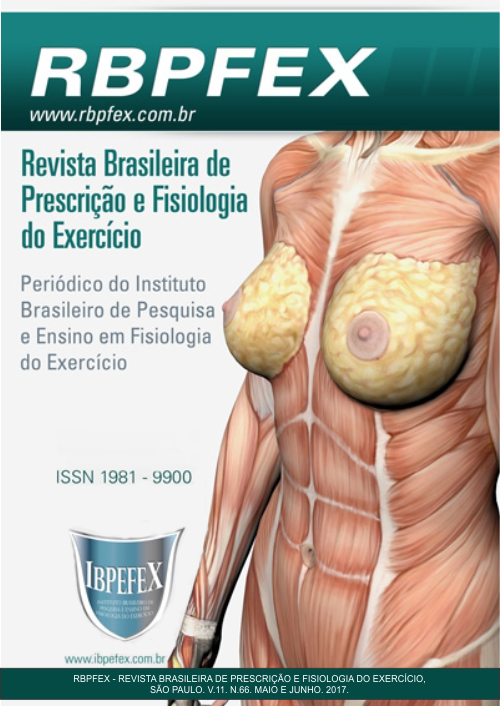Relationship of muscle imbalances in football players: a cross-current study
Abstract
Aim: To get information about isokinetic knee muscle strength imbalance of Brazilian athletes from elite football in the Under17, Under20 and adult professional categories and to explore relationships with their playing positions. Materials and Methods: The sample composed by 105 athletes. They were divided into three categories by age: Under17, Under20 and Professional. The playing positions were established as follows: Goalkeeper, External Defender, Defender, Defensive Midfielder, Midfielder and Forward. All subjects were submitted to isokinetic strength test, performed for the quadriceps and isquiosurais musculature, at 60º / s with five maximum repetitions. Results: After descriptive analysis, it was observed that 49% of athletes have imbalance. After analyzing the categories, 40% of Under17 athletes showed imbalance, 37.1% of Under20 athletes and 38.2% of professional athletes presented imbalance. Regarding the bilateral imbalance, it was noted that 20% of Under17 athletes, 28.6% of SUB-20 athletes and 32.4% of professionals had imbalance. It was also observed that 66.7% of the goalkeepers had unilateral imbalance and 33.3% bilateral. However, 70.6% of the forwards show some kind of imbalance (uniateral or bilateral). Conclusions: Therefore, almost half of the evaluated athletes presents muscle imbalance, and athletes Under17 and Under20 are not physically suitable to train at the level of professional players, given that they have greater level of muscle imbalance and hence potentially increased risk of injury. Furthermore, the Forward position stands for the highest degree of muscle imbalance between the six positions analyzed.
References
-Ayala, F.; Baranda, P.S.; De Ste Croix, M.; Santonja, F. Validity and reliability of isokinetic strength ratios for estimation of muscle imbalances. Apunts. Medicina de l'Esport. Vol. 47. Num. 176. 2012. p. 1016.
-Croisier, J.L.; Reveillon, V.; Ferret, J.M.; Cotte, T.; Genty, M. Isokinetic assessment of knee flexors and extensors in professional soccer players. Isokinetics and Exercise Science. Vol. 11. Num. 1. 2003. p. 61-62.
-Faulkner, J.A. Physiology of swimming and diving. Falls,H. Exercise physiology. Baltimore. Academic press. 1968.
-Gioftsidou, A.; Ispirlidis, I.; Pafis, G.; Malliou, P.; Bikos, C.; Godolias, G. Isokinetic strength training program for muscular imbalances in professional soccer players. Sport Sci Health. Vol. 2. Num. 1. 2008. p. 101-105.
-Hamzeh, M.; Head, A. Isokinetic hamstrings and quadriceps evaluation of professional soccer players. Journal of Sports Sciences. Vol. 22. Num. 2. 2004. p. 265.
-Holcomb, W.R.; Rubley, M.D.; Lee, H.J.; Guadagnoli, M.A. Effect of hamstring-emphasized resistance training on hamstring:quadriceps strength ratios. Journal of Strength and Conditioning Research. Vol. 21. Num. 1. 2007. p. 41-47.
-Hom, I.; Steen, H.; Olstad, M. Isokinetic muscle performance in growing boys from pre-teen to maturity. An eleven-year longitudinal study. Isokinetics and Exercise Science. Vol. 13 Num. 4. 2005. p. 153-158.
-Lehance, C.; Binet, J.; Bury, T.; Croisier, J.L. Muscular strength, functional performances and injury risk in professional and junior elite soccer players. Scand J Med Sci Sports. Vol. 10. Num. 11. 2008. p. 1600-0838.
-Nedeljkovic, A.; Mirkov, D.M.; Kukolj, M.; Ugarkovic, D.; Jaric, S. Effect of maturation on the relationshipbetween physical performance and body size. Journal of Strength and Conditioning Research. Vol. 21. Num. 1. 2007. p. 245-250.
-Tourny-Chollet, C.; Leroy, D.; Delarue, Y.; Beuret-Blanquart, F. Isokinetic-based comparison of hamstrings-quadriceps ratio between soccer players and sedentary subjects. Isokinetics and Exercise Science. Vol. 11. Num. 1. 2003. p. 85-86.
-Tourny-Chollet, C.; Leroy, D.; Léger, H.; Beuret-Blanquart, F. Isokinetic knee muscle strength of soccer players according to their position. Isokinetics and Exercise Science. Vol. 8. Num 1. 2000. p. 187-193.
-Tsikanos, A.;Paschoalis, V.;Valasotiris,K. Knee extension strength profile of elite Greek soccer players. Isokinects and Exercise Science. Vol. 24. Num 1. 2016. p. 79-82.
Authors who publish in this journal agree to the following terms:
- Authors retain the copyright and grant the journal the right of first publication, with work simultaneously licensed under the Creative Commons Attribution License BY-NC which allows the sharing of the work with acknowledgment of the authorship of the work and initial publication in this journal.
- Authors are authorized to enter into additional contracts separately for non-exclusive distribution of the version of the work published in this journal (eg, publishing in institutional repository or book chapter), with acknowledgment of authorship and initial publication in this journal.
- Authors are allowed and encouraged to post and distribute their work online (eg, in institutional repositories or on their personal page) at any point before or during the editorial process, as this can bring about productive change as well as increase impact and impact. citation of published work (See The Effect of Free Access).






